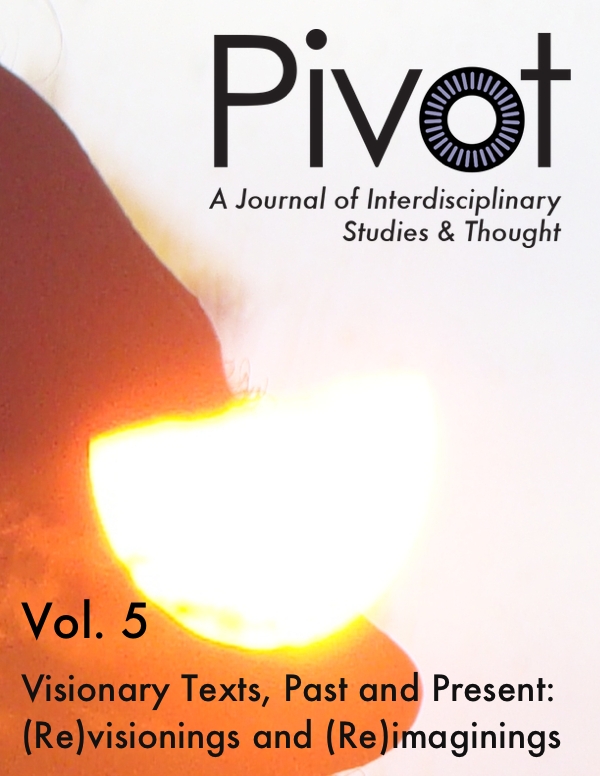Primates in Print: Popularizing Interspecies Kinship in Huxley's 'Evidence as to Man's Place in Nature'
DOI:
https://doi.org/10.25071/2369-7326.40250Abstract
This paper examines the bibliographic features of Thomas H. Huxley’s 1863 work Evidence as to Man’s Place in Nature in order to focalize Huxley’s public engagement with non-professional audiences and consumerist market forces. Huxley’s shaping of Victorian scientific practices and his cultural contributions to natural history have been thoroughly documented, yet the hermeneutic potential of the popular work’s bibliographic and visual elements has not been adequately addressed. When amalgamated through a re-conceived process of reading, the textual and visual features of Evidence materialize the evidence of evolutionary processes to which humans themselves are subject to. After confronting humans and primates in print, Huxley’s audience understood that the socio-cultural barriers to the dismantling of animal/human dichotomies imposed by humanist ideology were made available to rational critique. Because of its wide-ranging success as a catalyst of public—not just professional—acknowledgment of evolution, I contend that Evidence’s physical and visual features should not be overlooked as major contributing factors in the dissemination and acceptance of natural explanation. This research engages with pressing questions concerning the interclass popularization of Victorian science: how did tactile decisions about the object fashion its own reception? Can evolution be presented via visual rather than purely conceptual means? How immersed was Huxley’s product in burgeoning capitalistic forces? Ultimately, understanding Evidence’s status as a marketable visual product sheds light on how Victorians (professional and colloquial subjects alike) propagated, absorbed, and contemplated the ramifications of evolution.
References
Advertisement for Evidence as to Man’s Place in Nature. The Athenæum 30 Jan. 1864: 142. Web. 9 June 2016.
Agamben, Giorgio. The Open: Man and Animal. Trans. Kevin Attell. Stanford: Stanford UP, 2004. Print.
“Ape, n.” The Oxford English Dictionary. Oxford UP, n.d. Web. 9 June 2016.
Banham, Rob. “The Industrialization of the Book.” A Companion to the History of the Book, Eds. Simon Eliot and Jonathan Rose. Chichester: Wiley-Blackwell, 2009. 273-90. Print.
Beer, Gillian. Darwin’s Plots: Evolutionary Narratives in Darwin, George Eliot and Nineteenth Century Fiction. 3rd ed. Cambridge: Cambridge UP, 2009. Print. DOI: https://doi.org/10.1017/CBO9780511770401
Beer, Gillian. Open Fields: Science in Cultural Encounter. Oxford: Clarendon, 1996. Print.
Bowler, Peter J. The Non-Darwinian Revolution. Baltimore: Johns Hopkins UP, 1988. Print.
Brink-Roby, Heather. “Natural Representation: Diagram and Text in Darwin's On the Origin of Species.” Victorian Studies 51:2 (2009). 247-73. Print.
Browne, Janet. “Darwin in Caricature.” The Art of Evolution. Ed. Barbara Larson. Hanover: Dartmouth UP, 2009. 18-39. Print.
Cosans, Christopher E. Owen’s Ape and Darwin’s Bulldog. Bloomington: Indiana UP, 2009. Print.
Darwin, Charles. The Descent of Man. Ed. Carl Zimmer. New York: Plume, 2007. Print.
Darwin, Charles. The Origin of Species. 1st ed. London: John Murray, 1859. Print.
Darwin, Charles. Letter to J.D. Hooker. 30 Jan. 1863. Darwin Correspondence Project. University of Cambridge, n.d. Web. 9 June 2016.
Di Gregorio, Mario A. T.H. Huxley’s Place in Natural Science. New Haven: Yale UP, 1984. Print.
Flint, Kate. The Victorians and the Visual Imagination. Cambridge: Cambridge UP, 2000. Print.
Flower, W.H. “1860-1863.” Life and Letters of Thomas H. Huxley. Ed. Leonard Huxley. New York: Appleton, 1900. Print.
Foucault, Michel. The Order of Things: An Archaeology of the Human Sciences. New York: Random House, 1970. Print.
Gallagher, Catherine, and Stephen Greenblatt. Practicing New Historicism. Chicago: Chicago UP, 2000. 163-210. Print.
Genette, Gérard. Paratexts: Thresholds of Interpretation. Cambridge: Cambridge UP, 1997. Print.
Grosz, Elizabeth. Becoming Undone: Darwinian Reflections on Life, Politics, and Art. Durham: Duke UP, 2011. Print. DOI: https://doi.org/10.1215/9780822394433
Hesketh, Ian. Of Apes and Ancestors: Evolution, Christianity, and the Oxford Debate. Toronto: Toronto UP, 2009. Print.
Hurley, Kelly. The Gothic Body: Sexuality, Materialism, and Degeneration at the Fin de Siècle. Cambridge: Cambridge UP, 1996. Print. DOI: https://doi.org/10.1017/CBO9780511519161
Huxley, Thomas Henry. “Advertisement to the Reader.” Evidence as to Man’s Place in Nature. London: Williams and Norgate, 1863. N.pag. Print.
Huxley, Thomas Henry. Autobiography and Essays. New York: Cosimo, 2005. Print.
Huxley, Thomas Henry. Evidence as to Man’s Place in Nature. London: Williams and Norgate, 1863. Print.
Huxley, Thomas Henry. “Owen’s Position in the Anatomical History of Science.” The Life of Richard Owen. Vol. II. New York: Cambridge UP, 2011. 273-332. Print.
Huxley, Thomas Henry. “Evolution and Ethics.” Evolution and Ethics and Other Essays. New York: Appleton, 1896. 46-116. Print. DOI: https://doi.org/10.1037/13730-002
Lightman, Bernard. Victorian Popularizers of Science: Designing Nature for New Audiences. Chicago: Chicago UP, 2007. Print. DOI: https://doi.org/10.7208/chicago/9780226481173.001.0001
Mitchell, W.J.T. Iconology: Image, Text, Ideology. Chicago: Chicago UP, 1987. Print.
Rose, Jonathan. The Intellectual Life of the British Working Classes. London: Yale UP, 2002. Print.
Sabloff, Annabelle. Reordering the Natural World: Humans and Animals in the City. Toronto: Toronto UP, 2001. Print. DOI: https://doi.org/10.3138/9781442679221
Shapin, Steve. “Pump and Circumstance: Robert Boyle’s Literary Technology.” Social Studies of Science 14 (1984): 481-520. Print. DOI: https://doi.org/10.1177/030631284014004001
Smith, Jonathan. Charles Darwin and Victorian Visual Culture. New York: Cambridge UP, 2006. Print.


